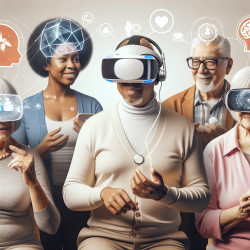Introduction
Virtual Reality (VR) is not just a tool for gaming or entertainment; it is rapidly becoming a vital instrument in enhancing the lives of older adults, especially those with cognitive impairments. The study titled "Testing the Feasibility of Virtual Reality With Older Adults With Cognitive Impairments and Their Family Members Who Live at a Distance" sheds light on the potential of VR to bridge the gap between older adults and their family members who live far away. This blog explores how practitioners can leverage these findings to improve outcomes for older adults in senior living communities.
The Power of VR in Enhancing Engagement
The study involved 21 residents from a senior living community and their family members, who engaged in VR sessions designed to enhance social connections. The results were promising, showing that VR was not only safe and easy to use but also highly satisfying for both residents with mild cognitive impairment (MCI) and mild-to-moderate dementia.
Data-driven insights from the study revealed that residents were more conversationally and behaviorally engaged during VR sessions compared to traditional telephone calls. This was particularly evident in sessions that incorporated reminiscence therapy, where residents and their family members revisited past memories together. This suggests that VR can be a powerful tool in promoting engagement and maintaining family connections.
Implications for Practitioners
For practitioners working with older adults, the study highlights several key takeaways:
- Enhanced Engagement: VR sessions can significantly increase conversational and behavioral engagement, making them a valuable addition to therapy programs.
- Reminiscence Therapy: Incorporating reminiscence therapy into VR sessions can deepen engagement and foster meaningful interactions between residents and their family members.
- Ease of Use: The study demonstrated that VR is accessible and easy to use for older adults, even those with cognitive impairments, suggesting that practitioners can confidently integrate VR into their therapeutic practices.
Encouraging Further Research
While the study provides a strong foundation, there is a need for further research to explore the long-term benefits of VR for older adults. Future studies could investigate the impact of VR on quality of life, depression, and anxiety levels among older adults and their family members. Additionally, exploring the use of VR in other therapeutic contexts could provide valuable insights into its broader applications.
Conclusion
Virtual Reality offers a promising avenue for enhancing family connections and engagement among older adults with cognitive impairments. By integrating VR into therapeutic practices, practitioners can create more meaningful and satisfying experiences for their clients. As the technology continues to evolve, it is essential for practitioners to stay informed and consider the potential benefits of VR in their work.
To read the original research paper, please follow this link: Testing the Feasibility of Virtual Reality With Older Adults With Cognitive Impairments and Their Family Members Who Live at a Distance.










